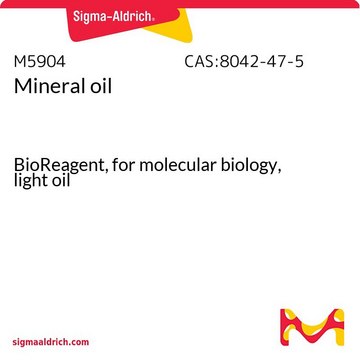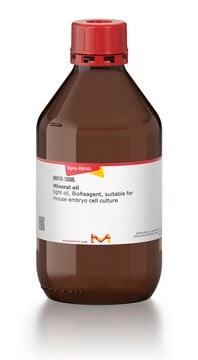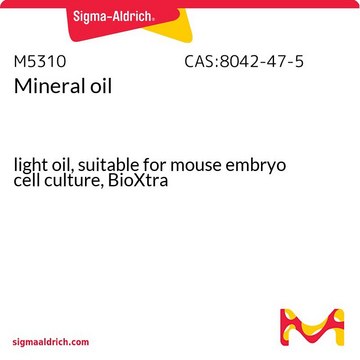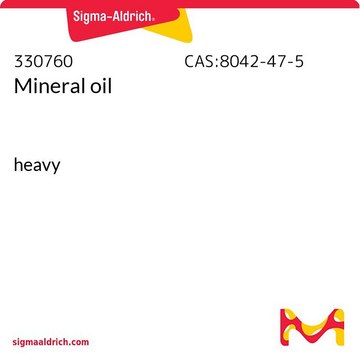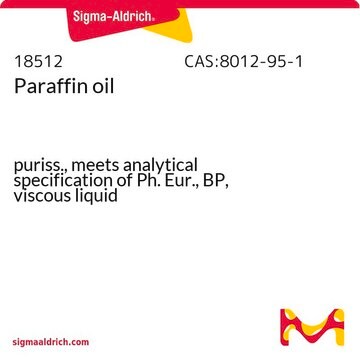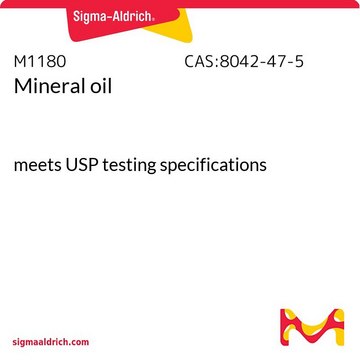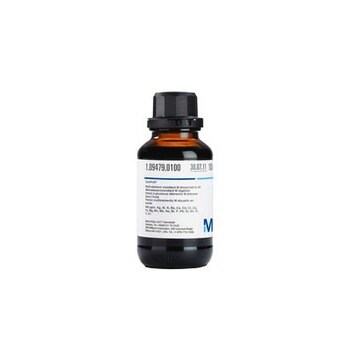Wichtige Dokumente
M8662
Mineralöl
PCR Reagent
Synonym(e):
Mineral oil for PCR
About This Item
Empfohlene Produkte
Qualität
PCR Reagent
Qualitätsniveau
Form
liquid
Verpackung
vial of 1.5 mL (Total volume 7.5 mL (5 vials))
Methode(n)
PCR: suitable
Farbe
colorless
Brechungsindex
n20/D 1.467 (lit.)
Dichte
0.84 g/mL at 25 °C (lit.)
Fremdaktivität
DNase, RNase, protease, none detected
Lagertemp.
room temp
InChIKey
AEOVEGJBKQQFOP-DDVLFWKVSA-L
Suchen Sie nach ähnlichen Produkten? Aufrufen Leitfaden zum Produktvergleich
Allgemeine Beschreibung
Anwendung
- für routinemäßige PCR-Amplifikationen
- zum Verbessern der Wärmeleitung zwischen dem Gerät und dem Cycler während der Reverse-Transkriptase-Polymerase-Kettenreaktion (RT–PCR)-Amplifikation
- zum Verhindern der Verdampfung während der Einzelzell-MATQ-Sequenzierung auf einer automatisierten Liquid-Handling-Plattform von Bravo.
Leistungsmerkmale und Vorteile
- Erhältlich in einer praktischen Packungsgröße von 5 × 1,5 ml (1 Fläschchen)
- Getestet auf das Nichtvorliegen von DNase, RNase und Protease
Lagerklassenschlüssel
10 - Combustible liquids
WGK
WGK 1
Flammpunkt (°F)
No data available
Flammpunkt (°C)
No data available
Persönliche Schutzausrüstung
Eyeshields, Gloves
Hier finden Sie alle aktuellen Versionen:
Besitzen Sie dieses Produkt bereits?
In der Dokumentenbibliothek finden Sie die Dokumentation zu den Produkten, die Sie kürzlich erworben haben.
Kunden haben sich ebenfalls angesehen
Protokolle
Method for bacterial genome analysis and detection of pathogens. Minimize false positive PCRs through lab design and reagents tested for use in bacterial PCR applications.
Protocol using antibody mediated hot start polymerase with a red dye for easy gel loading. Method has short activation period (<1min), and results in higher yields and more specificity over standard PCR methods.
Hot Start Taq Polymerase protocol to reduce non-specific amplification, with MgCl2 Optimization
Protocol using antibody mediated hot start polymerase. Method has short activation period (<1min), and results in higher yields and more specificity over standard PCR methods.
Unser Team von Wissenschaftlern verfügt über Erfahrung in allen Forschungsbereichen einschließlich Life Science, Materialwissenschaften, chemischer Synthese, Chromatographie, Analytik und vielen mehr..
Setzen Sie sich mit dem technischen Dienst in Verbindung.